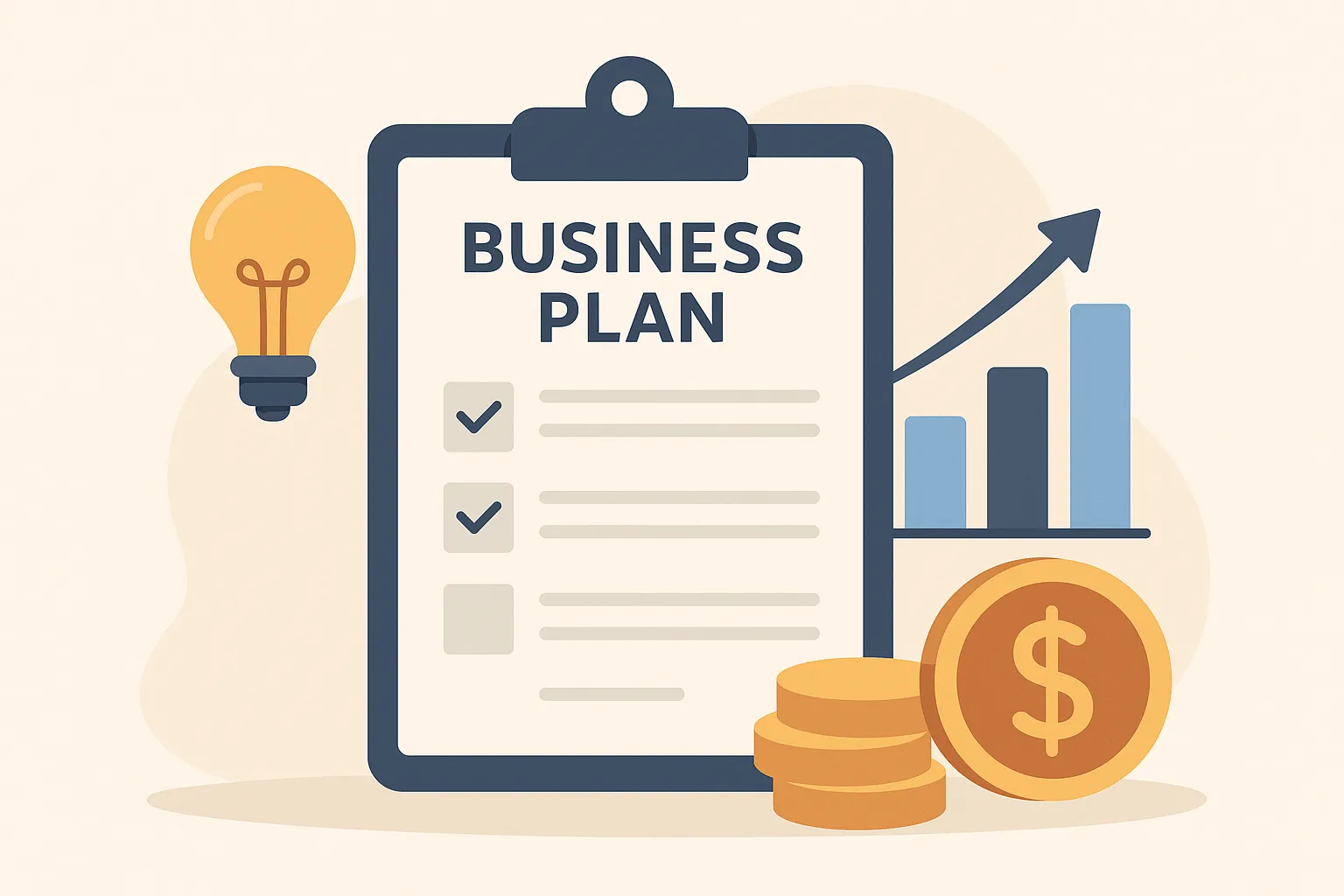Writing a business plan for investment isn’t just a formality—it’s your shot to prove you're worth betting on. Investors aren’t looking for fluff; they want clarity, strategy, and numbers that make sense.
In fact, according to SCORE, startups with a formal business plan are 30% more likely to secure funding.
So if you're serious about raising capital, this guide will walk you through what matters, what doesn’t, and how to make your plan stand out (without putting anyone to sleep).
What is a Business Plan?

A business plan is a written guide that explains what your business is, how it works, and how it will grow. Think of it like a roadmap.
It shows where you’re going and how you'll get there. Start your business plan with basic information like your company name and location.
If you're looking to attract potential investors or apply for funding, you’ll need a clear and convincing business plan. It includes your business idea, your target market, and your business's goals, as well as how you’ll make money (your business model).
Why You Need a Business Plan for Investment

If you're starting a new business or growing an established business, you’ll need investment. But no investor will give you money without seeing a plan first. Why? Because they want to know:
- What is your mission statement?
- Who are your typical customers?
- Do you have a clear marketing strategy?
- What makes your business better than others (competitive advantage)?
- Can you explain your financial projections, cash flow, and balance sheet?
Did you know? According to Palo Alto Software, businesses with a formal business plan are twice as likely to grow or get funding.
A good plan shows investors:
- Your business goals
- Your company description
- The market analysis and market data you've gathered
- How much money you need (funding requests) and why
“Without a business plan, you’re just guessing. With one, you’re building a path to success.” — SCORE.org
Business Plan vs Traditional Business Plan: What’s the Difference?
How to Write a Business Plan for Investment Opportunity

1. Start with the End Goal: Why Should Someone Invest?
You need to answer this first: Why would someone put money into your business idea?
What to explain:
- Your business goals and vision
- What the investor will gain (equity, revenue share, or exit at initial public offering)
- How much money you need (funding requests) and where it will go
💬 Quote: “Investors don’t invest in ideas. They invest in outcomes.” — Sequoia Capital
How to do it
- Be clear about your plan to secure funding
- Break it into steps: setup, launch, growth
- Use a table to show estimated costs and expected returns
2. Open with a Strong Executive Summary
Your executive summary is the first thing investors read. If it’s weak, they might stop there.
What to include:
- Quick intro to your company description
- A summary of your business model, target market, and competitive advantage
- A simple chart of financial projections like revenue, cash flow, and profit
How to do it
- Keep it short—under one page
- Use simple language
- Think of it like a movie trailer: highlight the best parts
3. Explain the Problem You Solve—With Real Market Data

Investors don’t care about cool ideas. They care about market gaps.
What to include:
- A real-world problem that people or businesses face
- How your product solves that problem
- Any proof, research, or early feedback that shows people want your product
Use easy numbers: “50% of small businesses struggle with X” sounds more convincing than vague claims.
Conduct a Market Analysis to Validate Demand
- Now, prove the market is big and growing.
- How to do it:
- Do market research using sources like Statista or local reports
- Show size, trends, and forecasts
- Share market data like demographics or customer segments
- Do a competitor analysis: who else is out there, and how are you different?
4. Introduce Your Business Model Clearly
Your business model explains how you make money. It shows what you sell, who buys it, and how you keep the business running.
How to do it
- Explain your product or service in one line
- Show your pricing method (subscription, one-time, freemium)
- Mention your customer segments
- Add a simple diagram or flowchart
Why it matters: Investors want to know your plan is sustainable. If they don’t understand how you’ll earn, they won’t fund you.
📢 “If you can’t explain your business model on a napkin, you don’t have one.” – Peter Drucker
5. Define the Target Market and Customer Segments
Your target market is the group of people you want to reach. Customer segments are smaller groups inside your market with specific needs.
How to do it
- Describe your typical customers (age, habits, pain points)
- Use real market data and market research
- List where your audience lives (local, global, niche, etc.)
Why it matters: Investors want proof that people want your product and that you’ve included key details . The clearer you are, the more they’ll trust your plan.
Tip: Use a pie chart to show the size of your audience or industry share.
6. Show Off Your Competitive Advantage

This is what makes you better than your competitors. It could be intellectual property, pricing, service, or even timing.
How to do it
- Make a short competitor analysis
- Highlight your key partnerships, tech, or location benefits
- Mention if your idea is protected or hard to copy
Why it matters: A convincing business plan shows why your idea is different—and why it can win.
7. Lay Out Your Marketing Strategy & Sales Plan
Investors want to know how your company plans to sell. A good marketing strategy tells them how you will reach your target market. Your sales plan shows how you’ll turn leads into customers.
How to do it
- Start by listing your marketing efforts. Are you using social media, ads, email, or events?
- Next, explain how your sales team will work. What’s the process from first contact to final sale?
- Share how you plan to retain customers and grow referrals.
Pro Tip: Add numbers. Example: “We plan to reach 10,000 users in the first year through paid ads and email marketing.”
Also include:
- Who your typical customers are
- Your pricing model
- How you’ll measure success (sales KPIs)
8. Map Out Your Financial Projections
Financial projections, including your income statement, show investors what your business will earn and spend. It’s a way to prove your idea can make money.
How to do it
- Create 3–5 year forecasts for revenue, expenses, and cash flow
- Include key numbers:
- Balance sheet
- Income statements
- Funding requests
- Growth plans
- Be realistic. Avoid showing only huge profits. Show financial health backed by logic.
9. Include an Exit Strategy

An exit strategy tells investors how they’ll get their money back—hopefully with profit.
How to do it
- Mention possible paths like:
- Selling the company
- Going public (an initial public offering)
- Merging with another firm
- Explain your timeline (e.g., 5–7 years)
- Be clear about how investors will benefit
This shows:
- You’re thinking long term
- You care about secure funding and returns
- You understand the business journey
“Having an exit strategy makes your business plan for investment more complete and convincing.” – [Forbes]
10. Design for Clarity and Speed
A business plan for investment must be easy to scan. Investors don’t have time to dig. They should find key elements like your executive summary, business model, or financial projections in seconds.
How to do it
- Use clear headings like “Marketing Strategy” or “Exit Strategy.”
- Add bullet points to list important ideas, especially in your cash flow statements or income statements.
- Keep paragraphs short and to the point.
- Include charts for balance sheet, sales plan, or target market numbers.
- Add an organizational chart to show your management team.
Tip: Use a clean design template. “A clean layout improves understanding and builds trust,” says McKinsey’s 2024 investor readiness report.
Different Types of Business Plans and When to Use Them

1. Traditional Business Plan – For Raising Capital or Bank Loans
Traditional business plans follow a structured format used by banks and investors. This is the most detailed format. It includes everything: your executive summary, company description, financial projections, cash flow statement, and more.
You’ll use this plan if:
- You're applying for a bank loan
- You want to attract venture capital firms
- You need to show a clear marketing strategy and business model
According to the U.S. Small Business Administration, "Lenders and investors will request a traditional business plan if you’re seeking funding."
Use this plan when you need to prove your business is a safe bet.
2. Lean Startup Plan – For Fast-Moving Startups
This one’s short and simple. It focuses only on the key elements:
- Business idea
- Target market
- Revenue model
- Customer segments
It’s great when:
- You have just an idea but want feedback
- You’re in the early stages of business plan development
- You want to share your vision quickly
Use this when you want a fast overview with just the basics.
3. Internal Business Plan – For Existing Teams & Departments

This one stays in-house. It’s used by business owners or team leads to:
- Align the marketing plan and sales plan
- Track performance goals and business goals
- Map the supply chain, key partnerships, and team roles
It usually includes:
- Simple balance sheets
- Team structure (organizational chart)
- Focus on financial health, not flashy pitching
Use this when you're not asking for money but want to stay organized and focused.
4. Nonprofit Business Plan – For Grants and Donor Funding
If you run a sole proprietorship or nonprofit organization, your goal isn’t profit—it’s impact. But donors, grant providers, and even venture capital firms still want to know how their money will be used.
Here’s what to include:
- Your mission statement and company’s mission
- A clear financial plan that explains how donations are used
- Community impact goals and success metrics
- A simple cash flow statement and balance sheet
Use this plan when:
- Applying for grants
- Seeking funding from donors or foundations
- Aligning goals across teams or partners
5. One-Page Business Plan – For Pitching an Idea Quickly
Sometimes, less is more—especially when you're just starting out or meeting an investor for coffee. A one-page business plan gets straight to the point.
Key elements to include:
- Your business model in one sentence
- Who your target market is
- What makes you different (competitive advantage)
- A brief version of your marketing strategy
Use this when:
- You have just an idea and want quick feedback
- You’re testing investor interest before building a full plan
- You need a quick internal summary
6. Operational Business Plan – For Scaling Up a Growing Business

If you're running a growing business, you need a plan that focuses on day-to-day execution and long-term growth.
This plan is useful for:
- Managing teams and assigning roles with an organizational chart
- Tracking performance and business goals
- Laying out systems like supply chain and sales plan
- Monitoring financial health, including income statements and cash flow statements
According to a McKinsey report, businesses with clear operations planning grow 2x faster.
Use this plan when:
- You're expanding to new markets
- You want to streamline team operations
- You’re preparing for investment or acquisition
7. Investor-Focused Business Plan – For Securing Equity Investment
If you're looking for funding, this is the business plan for investment you need. It’s made to persuade investors, not just explain your business. They want to know how much they’ll earn and when.
Include these key elements:
- A short, clear executive summary
- Your business model and how you'll grow
- Market analysis with real market data
- Your competitive advantage and why now is the right time
- Strong financial projections, including cash flow statements and your balance sheet
- A clear exit strategy (like IPO or acquisition)
This type of plan is ideal when:
- You're pitching venture capital firms
- You’re planning a funding round
- You need to secure funding from potential investors
Conclusion
A comprehensive guide for investment is more than just paper—it’s your pitch to the world. Investors want clarity, numbers, and strong direction. Whether you're a business owner starting a small business or scaling an established business, your plan must show clear financial statements, your vision statement, and company’s goals.
As Warren Buffett once said, “Risk comes from not knowing what you’re doing.” So write with purpose. Use a business plan template or step-by-step guide to stay organized. Include external factors, your SWOT analysis, and how much funding you really need.
Make it count. Investors don’t guess—they decide based on data.








